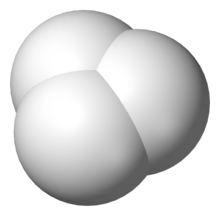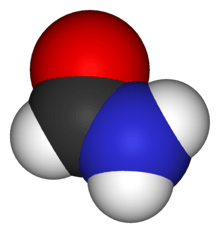List of interstellar and circumstellar molecules
This is a list of molecules that have been detected in the interstellar medium and circumstellar envelopes, grouped by the number of component atoms. The chemical formula is listed for each detected compound, along with any ionized form that has also been observed.
Background
The molecules listed below were detected through astronomical spectroscopy. Their spectral features arise because molecules either absorb or emit a photon of light when they transition between two molecular energy levels. The energy (and thus the wavelength) of the photon matches the energy difference between the levels involved. Molecular electronic transitions occur when one of the molecule's electrons moves between molecular orbitals, producing a spectral line in the ultraviolet, optical or near-infrared parts of the electromagnetic spectrum. Alternatively, a vibrational transition transfers quanta of energy to (or from) vibrations of molecular bonds, producing signatures in the mid- or far-infrared. Gas-phase molecules also have quantised rotational levels, leading to transitions at microwave or radio wavelengths.[1]
Sometimes a transition can involve more than one of these types of energy level e.g. ro-vibrational spectroscopy changes both the rotational and vibrational energy level. Occasionally all three occur together, as in the Phillips band of C2 (diatomic carbon), in which an electronic transition produces a line in the near-infrared, which is then split into several vibronic bands by a simultaneous change in vibrational level, which in turn are split again into rotational branches.[2]
The spectrum of a particular molecule is governed by the selection rules of quantum chemistry and the molecular symmetry. Some molecules have simple spectra which are easy to identify, whilst others (even some small molecules) have extremely complex spectra with flux spread among many different lines, making them far harder to detect.[3] Interactions between the atomic nuclei and the electrons sometimes causes further hyperfine structure of the spectral lines. If the molecule exists in multiple isotopologues (versions containing different atomic isotopes), the spectrum is further complicated by isotope shifts.
Detection of a new interstellar or circumstellar molecule requires identifying a suitable astronomical object where it is likely to be present, then observing it with a telescope equipped with a spectrograph working at the required wavelength, spectral resolution and sensitivity. The first molecule detected in the interstellar medium was the methylidyne radical (CH•) in 1937, through its strong electronic transition at 4300 angstroms (in the optical).[4] Advances in astronomical instrumentation have led to increasing numbers of new detections. From the 1950s onwards, radio astronomy began to dominate new detections, with sub-mm astronomy also becoming important from the 1990s.[3]
The inventory of detected molecules is highly biased towards certain types which are easier to detect e.g. radio astronomy is most sensitive to small linear molecules with a high molecular dipole.[3] The most common molecule in the Universe, H2 (molecular hydrogen) is completely invisible to radio telescopes because it has no dipole;[3] its electronic transitions are too energetic for optical telescopes, so detection of H2 required ultraviolet observations with a sounding rocket.[5] Vibrational lines are often not specific to an individual molecule, allowing only the general class to be identified. For example, polycyclic aromatic hydrocarbons (PAHs) are known to be common in space due to their vibrational lines, which are widely observed in the mid-infrared, but it has not been possible to identify exactly which molecules are responsible.[6]
One of the richest sources for detecting interstellar molecules is Sagittarius B2 (Sgr B2), a giant molecular cloud near the centre of the Milky Way. About half of the molecules listed below were first found in Sgr B2, and many of the others have been subsequently detected there.[7] A rich source of circumstellar molecules is CW Leonis (also known as IRC +10216), a nearby carbon star, where about 50 molecules have been identified.[8] There is no clear boundary between interstellar and circumstellar media, so both are included in the tables below.
The discipline of astrochemistry includes understanding how these molecules form and explaining their abundances. The extremely low density of the interstellar medium is not conducive to the formation of molecules, making conventional gas-phase reactions between neutral species (atoms or molecules) inefficient. Many regions also have very low temperatures (typically 10 kelvin inside a molecular cloud), further reducing the reaction rates, or high ultraviolet radiation fields, which destroy molecules through photochemistry.[9] Explaining the observed abundances of interstellar molecules requires calculating the balance between formation and destruction rates using gas-phase ion chemistry (often driven by cosmic rays), surface chemistry on cosmic dust, radiative transfer including interstellar extinction, and sophisticated reaction networks.[10]
Molecules
The following tables list molecules that have been detected in the interstellar medium or circumstellar matter, grouped by the number of component atoms. Neutral molecules and their molecular ions are listed in separate columns; if there is no entry in the molecule column, only the ionized form has been detected. Designations (names of molecules) are those used in the scientific literature describing the detection; if none was given that field is left empty. Mass is listed in atomic mass units. Deuterated molecules, which contain at least one deuterium (2H) atom, have slightly different masses and are listed in a separate table. The total number of unique species, including distinct ionization states, is indicated in each section header.
Most of the molecules detected so far are organic. The only detected inorganic molecule with five or more atoms is SiH4.[11] Molecules larger than that all have at least one carbon atom, with no N−N or O−O bonds.[11]
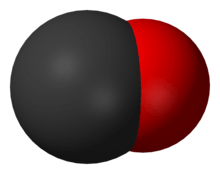
Diatomic (43)
Triatomic (44)
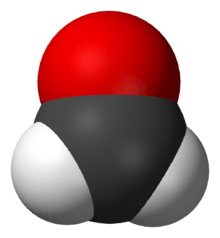
Four atoms (28)
| Molecule | Designation | Mass | Ions |
|---|---|---|---|
| CH3 | Methyl radical[88] | 15 | — |
| l-C3H | Propynylidyne[13][89] | 37 | l-C3H+[90] |
| c-C3H | Cyclopropynylidyne[91] | 37 | — |
| C3N | Cyanoethynyl[92] | 50 | C3N−[93] |
| C3O | Tricarbon monoxide[89] | 52 | — |
| C3S | Tricarbon sulfide[13][59] | 68 | — |
| — | Hydronium | 19 | H3O+[94] |
| C2H2 | Acetylene[95] | 26 | — |
| H2CN | Methylene amidogen[96] | 28 | H2CN+[24] |
| H2CO | Formaldehyde[87] | 30 | — |
| H2CS | Thioformaldehyde[97] | 46 | — |
| HCCN | —[98] | 39 | — |
| HCCO | Ketenyl[99] | 41 | — |
| — | Protonated hydrogen cyanide | 28 | HCNH+[73] |
| — | Protonated carbon dioxide | 45 | HOCO+[100] |
| HCNO | Fulminic acid[101] | 43 | — |
| HOCN | Cyanic acid[102] | 43 | — |
| CNCN | Isocyanogen[103] | 52 | — |
| HOOH | Hydrogen peroxide[104] | 34 | — |
| HNCO | Isocyanic acid[83] | 43 | — |
| HNCS | Isothiocyanic acid[105] | 59 | — |
| NH3 | Ammonia[13][106] | 17 | — |
| HSCN | Thiocyanic acid[107] | 59 | — |
| SiC3 | Silicon tricarbide[13] | 64 | — |
| HMgNC | Hydromagnesium isocyanide[108] | 51.3 | — |
| HNO2 | Nitrous acid[109] | 47 | — |
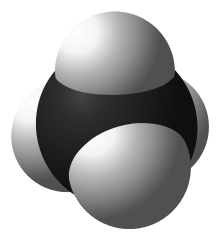
Five atoms (20)
| Molecule | Designation | Mass | Ions |
|---|---|---|---|
| — | Ammonium ion[111][112] | 18 | NH+ 4 |
| CH4 | Methane[113] | 16 | — |
| CH3O | Methoxy radical[114] | 31 | — |
| c-C3H2 | Cyclopropenylidene[25][115][116] | 38 | — |
| l-H2C3 | Propadienylidene[116] | 38 | — |
| H2CCN | Cyanomethyl[117] | 40 | — |
| H2C2O | Ketene[83] | 42 | — |
| H2CNH | Methylenimine[118] | 29 | — |
| HNCNH | Carbodiimide[119] | 42 | — |
| — | Protonated formaldehyde | 31 | H2COH+[120] |
| C4H | Butadiynyl[13] | 49 | C4H−[121] |
| HC3N | Cyanoacetylene[13][25][73][122][123] | 51 | — |
| HCC-NC | Isocyanoacetylene[124] | 51 | — |
| HCOOH | Formic acid[125][122] | 46 | — |
| NH2CN | Cyanamide[126] | 42 | — |
| — | Protonated cyanogen | 53 | NCCNH+[127] |
| HC(O)CN | Cyanoformaldehyde[128] | 55 | — |
| C5 | Linear C5[129] | 60 | — |
| SiC4 | Silicon-carbide cluster[50] | 92 | — |
| SiH4 | Silane[130] | 32 | — |
Six atoms (16)
| Molecule | Designation | Mass | Ions |
|---|---|---|---|
| c-H2C3O | Cyclopropenone[132] | 54 | — |
| E-HNCHCN | E-Cyanomethanimine[133] | 54 | — |
| C2H4 | Ethylene[134] | 28 | — |
| CH3CN | Acetonitrile[83][135][136] | 40 | — |
| CH3NC | Methyl isocyanide[135] | 40 | — |
| CH3OH | Methanol[83][137] | 32 | — |
| CH3SH | Methanethiol[138] | 48 | — |
| l-H2C4 | Diacetylene[13][139] | 50 | — |
| — | Protonated cyanoacetylene | 52 | HC3NH+[73] |
| HCONH2 | Formamide[131] | 44 | — |
| C5H | Pentynylidyne[13][59] | 61 | — |
| C5N | Cyanobutadiynyl radical[140] | 74 | — |
| HC2CHO | Propynal[141] | 54 | — |
| HC4N | —[13] | 63 | — |
| CH2CNH | Ketenimine[115] | 40 | — |
| C5S | —[142] | 92 | — |

Seven atoms (12)
| Molecule | Designation | Mass | Ions |
|---|---|---|---|
| c-C2H4O | Ethylene oxide[144] | 44 | — |
| CH3C2H | Methylacetylene[25] | 40 | — |
| H3CNH2 | Methylamine[145] | 31 | — |
| CH2CHCN | Acrylonitrile[83][135] | 53 | — |
| H2CHCOH | Vinyl alcohol[143] | 44 | — |
| C6H | Hexatriynyl radical[13][59] | 73 | C6H−[116][146] |
| HC4CN | Cyanodiacetylene[83][123][135] | 75 | — |
| HC5O | —[147] | 77 | — |
| CH3CHO | Acetaldehyde[13][144] | 44 | — |
| CH3NCO | Methyl isocyanate[148] | 57 | — |
| HOCH2CN | Glycolonitrile[149] | 57 | — |
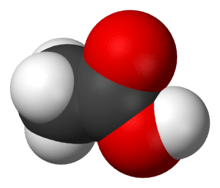
Eight atoms (11)
| Molecule | Designation | Mass |
|---|---|---|
| H3CC2CN | Methylcyanoacetylene[151] | 65 |
| H2COHCHO | Glycolaldehyde[152] | 60 |
| HCOOCH3 | Methyl formate[83][122][152] | 60 |
| CH3COOH | Acetic acid[150] | 60 |
| H2C6 | Hexapentaenylidene[13][139] | 74 |
| CH2CHCHO | Propenal[115] | 56 |
| CH2CCHCN | Cyanoallene[115][151] | 65 |
| CH3CHNH | Ethanimine[153] | 43 |
| C7H | Heptatrienyl radical[154] | 85 |
| NH2CH2CN | Aminoacetonitrile[155] | 56 |
| (NH2)2CO | Urea[156] | 60 |
Nine atoms (10)
| Molecule | Designation | Mass | Ions |
|---|---|---|---|
| CH3C4H | Methyldiacetylene[157] | 64 | — |
| CH3OCH3 | Dimethyl Ether[158] | 46 | — |
| CH3CH2CN | Propionitrile[13][83][135] | 55 | — |
| CH3CONH2 | Acetamide[115][131] | 59 | — |
| CH3CH2OH | Ethanol[159] | 46 | — |
| C8H | Octatetraynyl radical[160] | 97 | C8H−[161][162] |
| HC7N | Cyanohexatriyne or Cyanotriacetylene[13][106][163][164] | 99 | — |
| CH3CHCH2 | Propylene (propene)[165] | 42 | — |
| CH3CH2SH | Ethyl mercaptan[166] | 62 | — |
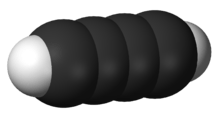
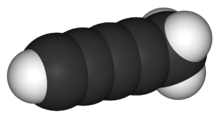

Ten or more atoms (17)
| Atoms | Molecule | Designation | Mass | Ions |
|---|---|---|---|---|
| 10 | (CH3)2CO | Acetone[83][167] | 58 | — |
| 10 | (CH2OH)2 | Ethylene glycol[168][169] | 62 | — |
| 10 | CH3CH2CHO | Propanal[115] | 58 | — |
| 10 | CH3OCH2OH | Methoxymethanol[170] | 62 | — |
| 10 | CH3C5N | Methylcyanodiacetylene[115] | 89 | — |
| 10 | CH3CHCH2O | Propylene oxide[171] | 58 | — |
| 11 | HC8CN | Cyanotetraacetylene[13][163] | 123 | — |
| 11 | C2H5OCHO | Ethyl formate[172] | 74 | — |
| 11 | CH3COOCH3 | Methyl acetate[173] | 74 | — |
| 11 | CH3C6H | Methyltriacetylene[115][157] | 88 | — |
| 12 | C6H6 | Benzene[139] | 78 | — |
| 12 | C3H7CN | n-Propyl cyanide[172] | 69 | — |
| 12 | (CH3)2CHCN | iso-Propyl cyanide[174][175] | 69 | — |
| 13 | C 6H 5CN | Benzonitrile[176] | 104 | — |
| 13 | HC10CN | Cyanopentaacetylene[163] | 147 | — |
| 60 | C60 | Buckminsterfullerene (C60 fullerene)[177] | 720 | C+ 60[178][179][180] |
| 70 | C70 | C70 fullerene[177] | 840 | — |
Deuterated molecules (20)
These molecules all contain one or more deuterium atoms, a heavier isotope of hydrogen.
| Atoms | Molecule | Designation |
|---|---|---|
| 2 | HD | Hydrogen deuteride[181][182] |
| 3 | H2D+, HD+ 2 | Trihydrogen cation[181][182] |
| 3 | HDO, D2O | Heavy water[183][184] |
| 3 | DCN | Hydrogen cyanide[185] |
| 3 | DCO | Formyl radical[185] |
| 3 | DNC | Hydrogen isocyanide[185] |
| 3 | N2D+ | —[185] |
| 4 | NH2D, NHD2, ND3 | Ammonia[182][186][187] |
| 4 | HDCO, D2CO | Formaldehyde[182][188] |
| 4 | DNCO | Isocyanic acid[189] |
| 5 | NH3D+ | Ammonium ion[190][191] |
| 6 | NH 2CDO; NHDCHO | Formamide[189] |
| 7 | CH2DCCH, CH3CCD | Methylacetylene[192][193] |
Unconfirmed (12)
Evidence for the existence of the following molecules has been reported in the scientific literature, but the detections are either described as tentative by the authors, or have been challenged by other researchers. They await independent confirmation.
| Atoms | Molecule | Designation |
|---|---|---|
| 2 | SiH | Silylidine[70] |
| 4 | PH3 | Phosphine[194] |
| 4 | MgCCH | Magnesium monoacetylide[142] |
| 4 | NCCP | Cyanophosphaethyne[142] |
| 5 | H2NCO+ | —[195] |
| 4 | SiH3CN | Silyl cyanide[142] |
| 10 | H2NCH2COOH | Glycine[196][197] |
| 12 | CO(CH2OH)2 | Dihydroxyacetone[198] |
| 12 | C2H5OCH3 | Ethyl methyl ether[199] |
| 18 | C 10H+ 8 | Naphthalene cation[200] |
| 24 | C24 | Graphene[201] |
| 24 | C14H10 | Anthracene[202][203] |
| 26 | C16H10 | Pyrene[202] |
See also
- Abiogenesis
- Astrobiology
- Astrochemistry
- Atomic and molecular astrophysics
- Cosmic dust
- Cosmic ray
- Cosmochemistry
- Diffuse interstellar band
- Extraterrestrial liquid water
- Forbidden mechanism
- Hemolithin
- Intergalactic dust
- Interplanetary medium
- Interstellar medium
- Lists of molecules
- Molecules in stars
- Non-proteinogenic amino acids
- Organic compound
- Outer space
- Panspermia
- Polycyclic aromatic hydrocarbon (PAH)
- Spectroscopy
- Tholin
References
- Shu, Frank H. (1982), The Physical Universe: An Introduction to Astronomy, University Science Books, ISBN 978-0-935702-05-7
- Chaffee, Frederick H.; Lutz, Barry L.; Black, John H.; Vanden Bout, Paul A.; Snell, Ronald L. (1980). "Rotational fine-structure lines of interstellar C2 toward Zeta Persei". The Astrophysical Journal. 236: 474. Bibcode:1980ApJ...236..474C. doi:10.1086/157764.
- McGuire, Brett A. (2018). "2018 Census of Interstellar, Circumstellar, Extragalactic, Protoplanetary Disk, and Exoplanetary Molecules". The Astrophysical Journal Supplement Series. 239 (2): 17. arXiv:1809.09132. Bibcode:2018ApJS..239...17M. doi:10.3847/1538-4365/aae5d2.
- Woon, D. E. (May 2005), Methylidyne radical, The Astrochemist, retrieved 2007-02-13
- Carruthers, George R. (1970), "Rocket Observation of Interstellar Molecular Hydrogen", Astrophysical Journal, 161: L81–L85, Bibcode:1970ApJ...161L..81C, doi:10.1086/180575
- Tielens, A.G.G.M. (2008). "Interstellar Polycyclic Aromatic Hydrocarbon Molecules". Annual Review of Astronomy and Astrophysics. 46: 289–337. Bibcode:2008ARA&A..46..289T. doi:10.1146/annurev.astro.46.060407.145211.
- Cummins, S. E.; Linke, R. A.; Thaddeus, P. (1986), "A survey of the millimeter-wave spectrum of Sagittarius B2", Astrophysical Journal Supplement Series, 60: 819–878, Bibcode:1986ApJS...60..819C, doi:10.1086/191102
- Kaler, James B. (2002), The hundred greatest stars, Copernicus Series, Springer, ISBN 978-0-387-95436-3, retrieved 2011-05-09
- Brown, Laurie M.; Pais, Abraham; Pippard, A. B. (1995), "The physics of the interstellar medium", Twentieth Century Physics (2nd ed.), CRC Press, p. 1765, ISBN 978-0-7503-0310-1
- Dalgarno, A. (2006), "Interstellar Chemistry Special Feature: The galactic cosmic ray ionization rate", Proceedings of the National Academy of Sciences, 103 (33): 12269–12273, Bibcode:2006PNAS..10312269D, doi:10.1073/pnas.0602117103, PMC 1567869, PMID 16894166
- Klemperer, William (2011), "Astronomical Chemistry", Annual Review of Physical Chemistry, 62: 173–184, Bibcode:2011ARPC...62..173K, doi:10.1146/annurev-physchem-032210-103332, PMID 21128763
- The Structure of Molecular Cloud Cores, Centre for Astrophysics and Planetary Science, University of Kent, retrieved 2007-02-16
- Ziurys, Lucy M. (2006), "The chemistry in circumstellar envelopes of evolved stars: Following the origin of the elements to the origin of life", Proceedings of the National Academy of Sciences, 103 (33): 12274–12279, Bibcode:2006PNAS..10312274Z, doi:10.1073/pnas.0602277103, PMC 1567870, PMID 16894164
- Cernicharo, J.; Guelin, M. (1987), "Metals in IRC+10216 - Detection of NaCl, AlCl, and KCl, and tentative detection of AlF", Astronomy and Astrophysics, 183 (1): L10–L12, Bibcode:1987A&A...183L..10C
- Ziurys, L. M.; Apponi, A. J.; Phillips, T. G. (1994), "Exotic fluoride molecules in IRC +10216: Confirmation of AlF and searches for MgF and CaF", Astrophysical Journal, 433 (2): 729–732, Bibcode:1994ApJ...433..729Z, doi:10.1086/174682
- Tenenbaum, E. D.; Ziurys, L. M. (2009), "Millimeter Detection of AlO (X2Σ+): Metal Oxide Chemistry in the Envelope of VY Canis Majoris", Astrophysical Journal, 694 (1): L59–L63, Bibcode:2009ApJ...694L..59T, doi:10.1088/0004-637X/694/1/L59
- Barlow, M. J.; Swinyard, B. M.; Owen, P. J.; Cernicharo, J.; Gomez, H. L.; Ivison, R. J.; Lim, T. L.; Matsuura, M.; Miller, S.; Olofsson, G.; Polehampton, E. T. (2013), "Detection of a Noble Gas Molecular Ion, 36ArH+, in the Crab Nebula", Science, 342 (6164): 1343–1345, arXiv:1312.4843, Bibcode:2013Sci...342.1343B, doi:10.1126/science.1243582, PMID 24337290
- Quenqua, Douglas (13 December 2013). "Noble Molecules Found in Space". New York Times. Retrieved 13 December 2013.
- Souza, S. P; Lutz, B. L (1977). "Detection of C2 in the interstellar spectrum of Cygnus OB2 number 12 /VI Cygni number 12/". The Astrophysical Journal. 216: L49. Bibcode:1977ApJ...216L..49S. doi:10.1086/182507.
- Lambert, D. L.; Sheffer, Y.; Federman, S. R. (1995), "Hubble Space Telescope observations of C2 molecules in diffuse interstellar clouds", Astrophysical Journal, 438: 740–749, Bibcode:1995ApJ...438..740L, doi:10.1086/175119
- Neufeld, D. A.; et al. (2006), "Discovery of interstellar CF+", Astronomy and Astrophysics, 454 (2): L37–L40, arXiv:astro-ph/0603201, Bibcode:2006A&A...454L..37N, doi:10.1051/0004-6361:200600015
- Landau, Elizabeth (12 October 2016). "Building Blocks of Life's Building Blocks Come From Starlight". NASA. Retrieved 13 October 2016.
- Adams, Walter S. (1941), "Some Results with the COUDÉ Spectrograph of the Mount Wilson Observatory", Astrophysical Journal, 93: 11–23, Bibcode:1941ApJ....93...11A, doi:10.1086/144237
- Smith, D. (1988), "Formation and Destruction of Molecular Ions in Interstellar Clouds", Philosophical Transactions of the Royal Society of London, 324 (1578): 257–273, Bibcode:1988RSPTA.324..257S, doi:10.1098/rsta.1988.0016
- Fuente, A.; et al. (2005), "Photon-dominated Chemistry in the Nucleus of M82: Widespread HOC+ Emission in the Inner 650 Parsec Disk", Astrophysical Journal, 619 (2): L155–L158, arXiv:astro-ph/0412361, Bibcode:2005ApJ...619L.155F, doi:10.1086/427990
- Guelin, M.; Cernicharo, J.; Paubert, G.; Turner, B. E. (1990), "Free CP in IRC + 10216", Astronomy and Astrophysics, 230: L9–L11, Bibcode:1990A&A...230L...9G
- Dopita, Michael A.; Sutherland, Ralph S. (2003), Astrophysics of the diffuse universe, Springer-Verlag, ISBN 978-3-540-43362-0
- Agúndez, M.; et al. (2010-07-30), "Astronomical identification of CN−, the smallest observed molecular anion", Astronomy & Astrophysics, 517: L2, arXiv:1007.0662, Bibcode:2010A&A...517L...2A, doi:10.1051/0004-6361/201015186, retrieved 2010-09-03
- Khan, Amina. "Did two planets around nearby star collide? Toxic gas holds hints". LA Times. Retrieved March 9, 2014.
- Dent, W.R.F.; Wyatt, M.C.;Roberge, A.; Augereau, J.-C.; Casassus, S.;Corder, S.; Greaves, J.S.; de Gregorio-Monsalvo, I; Hales, A.; Jackson, A.P.; Hughes, A. Meredith; Lagrange, A.-M; Matthews, B.; Wilner, D. (March 6, 2014). "Molecular Gas Clumps from the Destruction of Icy Bodies in the β Pictoris Debris Disk". Science. 343 (6178): 1490–1492. arXiv:1404.1380. Bibcode:2014Sci...343.1490D. doi:10.1126/science.1248726. PMID 24603151.CS1 maint: uses authors parameter (link)
- Latter, W. B.; Walker, C. K.; Maloney, P. R. (1993), "Detection of the Carbon Monoxide Ion (CO+) in the Interstellar Medium and a Planetary Nebula", Astrophysical Journal Letters, 419: L97, Bibcode:1993ApJ...419L..97L, doi:10.1086/187146
- Furuya, R. S.; et al. (2003), "Interferometric observations of FeO towards Sagittarius B2", Astronomy and Astrophysics, 409 (2): L21–L24, Bibcode:2003A&A...409L..21F, doi:10.1051/0004-6361:20031304
- Fisher, Christine (17 April 2019). "NASA finally found evidence of the universe's earliest molecule - The elusive helium hydride was found 3,000 light-years away". Engadget. Retrieved 17 April 2018.
- Güsten, Rolf; et al. (17 April 2019). "Astrophysical detection of the helium hydride ion HeH+". Nature. 568 (7752): 357–359. arXiv:1904.09581. Bibcode:2019Natur.568..357G. doi:10.1038/s41586-019-1090-x. PMID 30996316.
- Blake, G. A.; Keene, J.; Phillips, T. G. (1985), "Chlorine in dense interstellar clouds - The abundance of HCl in OMC-1" (PDF), Astrophysical Journal, Part 1, 295: 501–506, Bibcode:1985ApJ...295..501B, doi:10.1086/163394
- De Luca, M.; Gupta, H.; Neufeld, D.; Gerin, M.; Teyssier, D.; Drouin, B. J.; Pearson, J. C.; Lis, D. C.; et al. (2012), "Herschel/HIFI Discovery of HCl+ in the Interstellar Medium", The Astrophysical Journal Letters, 751 (2): L37, Bibcode:2012ApJ...751L..37D, doi:10.1088/2041-8205/751/2/L37
- Neufeld, David A.; et al. (1997), "Discovery of Interstellar Hydrogen Fluoride", Astrophysical Journal Letters, 488 (2): L141–L144, arXiv:astro-ph/9708013, Bibcode:1997ApJ...488L.141N, doi:10.1086/310942
- Wyrowski, F.; et al. (2009), "First interstellar detection of OH+", Astronomy & Astrophysics, 518: A26, arXiv:1004.2627, Bibcode:2010A&A...518A..26W, doi:10.1051/0004-6361/201014364
- Meyer, D. M.; Roth, K. C. (1991), "Discovery of interstellar NH", Astrophysical Journal Letters, 376: L49–L52, Bibcode:1991ApJ...376L..49M, doi:10.1086/186100
- Wagenblast, R.; et al. (January 1993), "On the origin of NH in diffuse interstellar clouds", Monthly Notices of the Royal Astronomical Society, 260 (2): 420–424, Bibcode:1993MNRAS.260..420W, doi:10.1093/mnras/260.2.420
- <Please add first missing authors to populate metadata.> (June 9, 2004), Astronomers Detect Molecular Nitrogen Outside Solar System, Space Daily, retrieved 2010-06-25
- Knauth, D. C; et al. (2004), "The interstellar N2 abundance towards HD 124314 from far-ultraviolet observations", Nature, 429 (6992): 636–638, Bibcode:2004Natur.429..636K, doi:10.1038/nature02614, PMID 15190346
- McGonagle, D.; et al. (1990), "Detection of nitric oxide in the dark cloud L134N", Astrophysical Journal, Part 1, 359 (1 Pt 1): 121–124, Bibcode:1990ApJ...359..121M, doi:10.1086/169040, PMID 11538685
- Staff writers (March 27, 2007), Elusive oxygen molecule finally discovered in interstellar space, Physorg.com, retrieved 2007-04-02
- Turner, B. E.; Bally, John (1987). "Detection of interstellar PN - the first identified phosphorus compound in the interstellar medium". The Astrophysical Journal. 321: L75. Bibcode:1987ApJ...321L..75T. doi:10.1086/185009.
- Ziurys, L. M. (1987), "Detection of interstellar PN - The first phosphorus-bearing species observed in molecular clouds", Astrophysical Journal Letters, 321 (1 Pt 2): L81–L85, Bibcode:1987ApJ...321L..81Z, doi:10.1086/185010, PMID 11542218
- Tenenbaum, E. D.; Woolf, N. J.; Ziurys, L. M. (2007), "Identification of phosphorus monoxide (X 2 Pi r) in VY Canis Majoris: Detection of the first PO bond in space", Astrophysical Journal Letters, 666 (1): L29–L32, Bibcode:2007ApJ...666L..29T, doi:10.1086/521361
- Yamamura, S. T.; Kawaguchi, K.; Ridgway, S. T. (2000), "Identification of SH v=1 Ro-vibrational Lines in R Andromedae", The Astrophysical Journal, 528 (1): L33–L36, arXiv:astro-ph/9911080, Bibcode:2000ApJ...528L..33Y, doi:10.1086/312420, PMID 10587489
- Menten, K. M.; et al. (2011), "Submillimeter Absorption from SH+, a New Widespread Interstellar Radical, 13CH+ and HCl", Astronomy & Astrophysics, 525: A77, arXiv:1009.2825, Bibcode:2011A&A...525A..77M, doi:10.1051/0004-6361/201014363, archived from the original on 2011-07-19, retrieved 2010-12-03.
- Pascoli, G.; Comeau, M. (1995), "Silicon Carbide in Circumstellar Environment", Astrophysics and Space Science, 226 (1): 149–163, Bibcode:1995Ap&SS.226..149P, doi:10.1007/BF00626907
- Kamiński, T.; et al. (2013), "Pure rotational spectra of TiO and TiO2 in VY Canis Majoris", Astronomy and Astrophysics, 551: A113, arXiv:1301.4344, Bibcode:2013A&A...551A.113K, doi:10.1051/0004-6361/201220290
- Oka, Takeshi (2006), "Interstellar H3+", Proceedings of the National Academy of Sciences, 103 (33): 12235–12242, Bibcode:2006PNAS..10312235O, doi:10.1073/pnas.0601242103, PMC 1567864, PMID 16894171
- Geballe, T. R.; Oka, T. (1996), "Detection of H3+ in Interstellar Space", Nature, 384 (6607): 334–335, Bibcode:1996Natur.384..334G, doi:10.1038/384334a0, PMID 8934516
- Tenenbaum, E. D.; Ziurys, L. M. (2010), "Exotic Metal Molecules in Oxygen-rich Envelopes: Detection of AlOH (X1Σ+) in VY Canis Majoris", Astrophysical Journal, 712 (1): L93–L97, Bibcode:2010ApJ...712L..93T, doi:10.1088/2041-8205/712/1/L93
- Hinkle, K. W; Keady, J. J; Bernath, P. F (1988). "Detection of C3 in the Circumstellar Shell of IRC+10216". Science. 241 (4871): 1319–22. Bibcode:1988Sci...241.1319H. doi:10.1126/science.241.4871.1319. PMID 17828935.
- Maier, John P; Lakin, Nicholas M; Walker, Gordon A. H; Bohlender, David A (2001). "Detection of C3 in Diffuse Interstellar Clouds". The Astrophysical Journal. 553 (1): 267–273. arXiv:astro-ph/0102449. Bibcode:2001ApJ...553..267M. doi:10.1086/320668.
- Anderson, J. K.; et al. (2014), "Detection of CCN (X2Πr) in IRC+10216: Constraining Carbon-chain Chemistry", Astrophysical Journal, 795 (1): L1, Bibcode:2014ApJ...795L...1A, doi:10.1088/2041-8205/795/1/L1
- Ohishi, Masatoshi, Masatoshi; et al. (1991), "Detection of a new carbon-chain molecule, CCO", Astrophysical Journal Letters, 380: L39–L42, Bibcode:1991ApJ...380L..39O, doi:10.1086/186168, PMID 11538087
- Irvine, William M.; et al. (1988), "Newly detected molecules in dense interstellar clouds", Astrophysical Letters and Communications, 26: 167–180, Bibcode:1988ApL&C..26..167I, PMID 11538461
- Halfen, D. T.; Clouthier, D. J.; Ziurys, L. M. (2008), "Detection of the CCP Radical (X 2Πr) in IRC +10216: A New Interstellar Phosphorus-containing Species", Astrophysical Journal, 677 (2): L101–L104, Bibcode:2008ApJ...677L.101H, doi:10.1086/588024
- Whittet, Douglas C. B.; Walker, H. J. (1991), "On the occurrence of carbon dioxide in interstellar grain mantles and ion-molecule chemistry", Monthly Notices of the Royal Astronomical Society, 252: 63–67, Bibcode:1991MNRAS.252...63W, doi:10.1093/mnras/252.1.63
- Cernicharo, J.; Velilla-Prieto, L.; Agúndez, M.; Pardo, J. R.; Fonfría, J. P.; Quintana-Lacaci, G.; Cabezas, C.; Bermúdez, C.; Guélin, M. (2019). "Discovery of the first Ca-bearing molecule in space: CaNC". Astronomy & Astrophysics. 627: L4. arXiv:1906.09352. Bibcode:2019A&A...627L...4C. doi:10.1051/0004-6361/201936040. PMC 6640036. PMID 31327871.
- Zack, L. N.; Halfen, D. T.; Ziurys, L. M. (June 2011), "Detection of FeCN (X 4Δi) in IRC+10216: A New Interstellar Molecule", The Astrophysical Journal Letters, 733 (2): L36, Bibcode:2011ApJ...733L..36Z, doi:10.1088/2041-8205/733/2/L36
- Hollis, J. M.; Jewell, P. R.; Lovas, F. J. (1995), "Confirmation of interstellar methylene", Astrophysical Journal, Part 1, 438: 259–264, Bibcode:1995ApJ...438..259H, doi:10.1086/175070
- Lis, D. C.; et al. (2010-10-01), "Herschel/HIFI discovery of interstellar chloronium (H2Cl+)", Astronomy & Astrophysics, 521: L9, arXiv:1007.1461, Bibcode:2010A&A...521L...9L, doi:10.1051/0004-6361/201014959.
- "Europe's space telescope ISO finds water in distant places", XMM-Newton Press Release: 12, April 29, 1997, Bibcode:1997xmm..pres...12., archived from the original on December 22, 2006, retrieved 2007-02-08
- Ossenkopf, V.; et al. (2010), "Detection of interstellar oxidaniumyl: Abundant H2O+ towards the star-forming regions DR21, Sgr B2, and NGC6334", Astronomy & Astrophysics, 518: L111, arXiv:1005.2521, Bibcode:2010A&A...518L.111O, doi:10.1051/0004-6361/201014577.
- Parise, B.; Bergman, P.; Du, F. (2012), "Detection of the hydroperoxyl radical HO2 toward ρ Ophiuchi A. Additional constraints on the water chemical network", Astronomy & Astrophysics Letters, 541: L11–L14, arXiv:1205.0361, Bibcode:2012A&A...541L..11P, doi:10.1051/0004-6361/201219379
- Snyder, L. E.; Buhl, D. (1971), "Observations of Radio Emission from Interstellar Hydrogen Cyanide", Astrophysical Journal, 163: L47–L52, Bibcode:1971ApJ...163L..47S, doi:10.1086/180664
- Schilke, P.; Benford, D. J.; Hunter, T. R.; Lis, D. C., Phillips, T. G.; Phillips, T. G. (2001), "A Line Survey of Orion-KL from 607 to 725 GHz", Astrophysical Journal Supplement Series, 132 (2): 281–364, Bibcode:2001ApJS..132..281S, doi:10.1086/318951
- Schilke, P.; Comito, C.; Thorwirth, S. (2003), "First Detection of Vibrationally Excited HNC in Space", The Astrophysical Journal, 582 (2): L101–L104, Bibcode:2003ApJ...582L.101S, doi:10.1086/367628
- Schenewerk, M. S.; Snyder, L. E.; Hjalmarson, A. (1986), "Interstellar HCO - Detection of the missing 3 millimeter quartet", Astrophysical Journal Letters, 303: L71–L74, Bibcode:1986ApJ...303L..71S, doi:10.1086/184655
- Kawaguchi, Kentarou; et al. (1994), "Detection of a new molecular ion HC3NH(+) in TMC-1", Astrophysical Journal, 420: L95, Bibcode:1994ApJ...420L..95K, doi:10.1086/187171
- Agúndez, M.; Cernicharo, J.; Guélin, M. (2007), "Discovery of Phosphaethyne (HCP) in Space: Phosphorus Chemistry in Circumstellar Envelopes", The Astrophysical Journal, 662 (2): L91, Bibcode:2007ApJ...662L..91A, doi:10.1086/519561, hdl:10261/191973
- Agúndez, M; Marcelino, N; Cernicharo, J; Tafalla, M (2018). "Detection of interstellar HCS and its metastable isomer HSC: New pieces in the puzzle of sulfur chemistry". Astronomy & Astrophysics. 611: L1. arXiv:1802.09401. Bibcode:2018A&A...611L...1A. doi:10.1051/0004-6361/201832743. PMC 6031296. PMID 29983448.
- Womack, M.; Ziurys, L. M.; Wyckoff, S. (1992), "A survey of N2H(+) in dense clouds - Implications for interstellar nitrogen and ion-molecule chemistry", Astrophysical Journal, Part 1, 387: 417–429, Bibcode:1992ApJ...387..417W, doi:10.1086/171094
- Hollis, J. M.; et al. (1991), "Interstellar HNO: Confirming the Identification - Atoms, ions and molecules: New results in spectral line astrophysics", Atoms, 16: 407–412, Bibcode:1991ASPC...16..407H
- van Dishoeck, Ewine F.; et al. (1993), "Detection of the Interstellar NH 2 Radical", Astrophysical Journal Letters, 416: L83–L86, Bibcode:1993ApJ...416L..83V, doi:10.1086/187076, hdl:1887/2194
- Ziurys, L. M.; et al. (1994), "Detection of interstellar N2O: A new molecule containing an N-O bond", Astrophysical Journal Letters, 436: L181–L184, Bibcode:1994ApJ...436L.181Z, doi:10.1086/187662
- Hollis, J. M.; Rhodes, P. J. (November 1, 1982), "Detection of interstellar sodium hydroxide in self-absorption toward the galactic center", Astrophysical Journal Letters, 262: L1–L5, Bibcode:1982ApJ...262L...1H, doi:10.1086/183900
- Goldsmith, P. F.; Linke, R. A. (1981), "A study of interstellar carbonyl sulfide", Astrophysical Journal, Part 1, 245: 482–494, Bibcode:1981ApJ...245..482G, doi:10.1086/158824
- Phillips, T. G.; Knapp, G. R. (1980), "Interstellar Ozone", American Astronomical Society Bulletin, 12: 440, Bibcode:1980BAAS...12..440P
- Johansson, L. E. B.; et al. (1984), "Spectral scan of Orion A and IRC+10216 from 72 to 91 GHz", Astronomy and Astrophysics, 130 (2): 227–256, Bibcode:1984A&A...130..227J
- Cernicharo, José; et al. (2015), "Discovery of SiCSi in IRC+10216: a Missing Link Between Gas and Dust Carriers OF Si–C Bonds", Astrophysical Journal Letters, 806 (1): L3, arXiv:1505.01633, Bibcode:2015ApJ...806L...3C, doi:10.1088/2041-8205/806/1/L3, PMC 4693961, PMID 26722621
- Guélin, M.; et al. (2004), "Astronomical detection of the free radical SiCN", Astronomy and Astrophysics, 363: L9–L12, Bibcode:2000A&A...363L...9G
- Guélin, M.; et al. (2004), "Detection of the SiNC radical in IRC+10216", Astronomy and Astrophysics, 426 (2): L49–L52, Bibcode:2004A&A...426L..49G, doi:10.1051/0004-6361:200400074
- Snyder, Lewis E.; et al. (1999), "Microwave Detection of Interstellar Formaldehyde", Physical Review Letters, 61 (2): 77–115, Bibcode:1969PhRvL..22..679S, doi:10.1103/PhysRevLett.22.679
- Feuchtgruber, H.; et al. (June 2000), "Detection of Interstellar CH3", The Astrophysical Journal, 535 (2): L111–L114, arXiv:astro-ph/0005273, Bibcode:2000ApJ...535L.111F, doi:10.1086/312711, PMID 10835311
- Irvine, W. M.; et al. (1984), "Confirmation of the Existence of Two New Interstellar Molecules: C3H and C3O", Bulletin of the American Astronomical Society, 16: 877, Bibcode:1984BAAS...16..877I
- Pety, J.; et al. (2012), "The IRAM-30 m line survey of the Horsehead PDR. II. First detection of the l-C3MH+ hydrocarbon cation", Astronomy & Astrophysics, 548: A68, arXiv:1210.8178, Bibcode:2012A&A...548A..68P, doi:10.1051/0004-6361/201220062
- Mangum, J. G.; Wootten, A. (1990), "Observations of the cyclic C3H radical in the interstellar medium", Astronomy and Astrophysics, 239: 319–325, Bibcode:1990A&A...239..319M
- Bell, M. B.; Matthews, H. E. (1995), "Detection of C3N in the spiral arm gas clouds in the direction of Cassiopeia A", Astrophysical Journal, Part 1, 438: 223–225, Bibcode:1995ApJ...438..223B, doi:10.1086/175066
- Thaddeus, P.; et al. (2008), "Laboratory and Astronomical Detection of the Negative Molecular Ion C3N-", The Astrophysical Journal, 677 (2): 1132–1139, Bibcode:2008ApJ...677.1132T, doi:10.1086/528947
- Wootten, Alwyn; et al. (1991), "Detection of interstellar H3O(+) - A confirming line", Astrophysical Journal Letters, 380: L79–L83, Bibcode:1991ApJ...380L..79W, doi:10.1086/186178
- Ridgway, S. T.; et al. (1976), "Circumstellar acetylene in the infrared spectrum of IRC+10216", Nature, 264 (5584): 345, 346, Bibcode:1976Natur.264..345R, doi:10.1038/264345a0
- Ohishi, Masatoshi; et al. (1994), "Detection of a new interstellar molecule, H2CN", Astrophysical Journal Letters, 427 (1): L51–L54, Bibcode:1994ApJ...427L..51O, doi:10.1086/187362, PMID 11539493
- Minh, Y. C.; Irvine, W. M.; Brewer, M. K. (1991), "H2CS abundances and ortho-to-para ratios in interstellar clouds", Astronomy and Astrophysics, 244: 181–189, Bibcode:1991A&A...244..181M, PMID 11538284
- Guelin, M.; Cernicharo, J. (1991), "Astronomical detection of the HCCN radical - Toward a new family of carbon-chain molecules?", Astronomy and Astrophysics, 244: L21–L24, Bibcode:1991A&A...244L..21G
- Agúndez, M.; et al. (2015), "Discovery of interstellar ketenyl (HCCO), a surprisingly abundant radical", Astronomy and Astrophysics, 577: L5, arXiv:1504.05721, Bibcode:2015A&A...577L...5A, doi:10.1051/0004-6361/201526317, PMC 4693959, PMID 26722130
- Minh, Y. C.; Irvine, W. M.; Ziurys, L. M. (1988), "Observations of interstellar HOCO(+) - Abundance enhancements toward the Galactic center", Astrophysical Journal, Part 1, 334 (1): 175–181, Bibcode:1988ApJ...334..175M, doi:10.1086/166827, PMID 11538465
- Marcelino, Núria; et al. (2009), "Discovery of fulminic acid, HCNO, in dark clouds", Astrophysical Journal, 690 (1): L27–L30, arXiv:0811.2679, Bibcode:2009ApJ...690L..27M, doi:10.1088/0004-637X/690/1/L27
- Brünken, S.; et al. (2010-07-22), "Interstellar HOCN in the Galactic center region", Astronomy & Astrophysics, 516: A109, arXiv:1005.2489, Bibcode:2010A&A...516A.109B, doi:10.1051/0004-6361/200912456
- Agúndez, M; Marcelino, N; Cernicharo, J (2018). "Discovery of Interstellar Isocyanogen (CNCN): Further Evidence that Dicyanopolyynes Are Abundant in Space". The Astrophysical Journal. 861 (2): L22. arXiv:1806.10328. Bibcode:2018ApJ...861L..22A. doi:10.3847/2041-8213/aad089. PMC 6120679. PMID 30186588.
- Bergman; Parise; Liseau; Larsson; Olofsson; Menten; Güsten (2011), "Detection of interstellar hydrogen peroxide", Astronomy & Astrophysics, 531: L8, arXiv:1105.5799, Bibcode:2011A&A...531L...8B, doi:10.1051/0004-6361/201117170.
- Frerking, M. A.; Linke, R. A.; Thaddeus, P. (1979), "Interstellar isothiocyanic acid", Astrophysical Journal Letters, 234: L143–L145, Bibcode:1979ApJ...234L.143F, doi:10.1086/183126
- Nguyen-Q-Rieu; Graham, D.; Bujarrabal, V. (1984), "Ammonia and cyanotriacetylene in the envelopes of CRL 2688 and IRC + 10216", Astronomy and Astrophysics, 138 (1): L5–L8, Bibcode:1984A&A...138L...5N
- Halfen, D. T.; et al. (September 2009), "Detection of a New Interstellar Molecule: Thiocyanic Acid HSCN", The Astrophysical Journal Letters, 702 (2): L124–L127, Bibcode:2009ApJ...702L.124H, doi:10.1088/0004-637X/702/2/L124
- Cabezas, C.; et al. (2013), "Laboratory and Astronomical Discovery of Hydromagnesium Isocyanide", Astrophysical Journal, 775 (2): 133, arXiv:1309.0371, Bibcode:2013ApJ...775..133C, doi:10.1088/0004-637X/775/2/133
- Coutens, A.; Ligterink, N. F. W.; Loison, J.-C.; Wakelam, V.; Calcutt, H.; Drozdovskaya, M. N.; Jørgensen, J. K.; Müller, H. S. P.; Van Dishoeck, E. F.; Wampfler, S. F. (2019). "The ALMA-PILS survey: First detection of nitrous acid (HONO) in the interstellar medium". Astronomy & Astrophysics. 623: L13. arXiv:1903.03378. Bibcode:2019A&A...623L..13C. doi:10.1051/0004-6361/201935040.
- Butterworth, Anna L.; et al. (2004), "Combined element (H and C) stable isotope ratios of methane in carbonaceous chondrites", Monthly Notices of the Royal Astronomical Society, 347 (3): 807–812, Bibcode:2004MNRAS.347..807B, doi:10.1111/j.1365-2966.2004.07251.x
- "NH4+ in the ISM". Archived from the original on 2015-05-26. Retrieved 2013-08-29.
- Detection Of The Ammonium Ion In Space - Iopscience
- Lacy, J. H.; et al. (1991), "Discovery of interstellar methane - Observations of gaseous and solid CH4 absorption toward young stars in molecular clouds", Astrophysical Journal, 376: 556–560, Bibcode:1991ApJ...376..556L, doi:10.1086/170304
- Cernicharo, J.; Marcelino, N.; Roueff, E.; Gerin, M.; Jiménez-Escobar, A.; Muñoz Caro, G. M. (2012), "Discovery of the Methoxy Radical, CH3O, toward B1: Dust Grain and Gas-phase Chemistry in Cold Dark Clouds", The Astrophysical Journal Letters, 759 (2): L43–L46, Bibcode:2012ApJ...759L..43C, doi:10.1088/2041-8205/759/2/L43
- Finley, Dave (August 7, 2006), "Researchers Use NRAO Telescope to Study Formation Of Chemical Precursors to Life", NRAO Press Release: 9, Bibcode:2006nrao.pres....9., retrieved 2006-08-10
- Fossé, David; et al. (2001), "Molecular Carbon Chains and Rings in TMC-1", Astrophysical Journal, 552 (1): 168–174, arXiv:astro-ph/0012405, Bibcode:2001ApJ...552..168F, doi:10.1086/320471
- Irvine, W. M.; et al. (1988), "Identification of the interstellar cyanomethyl radical (CH2CN) in the molecular clouds TMC-1 and Sagittarius B2", Astrophysical Journal Letters, 334 (2): L107–L111, Bibcode:1988ApJ...334L.107I, doi:10.1086/185323, PMID 11538463
- Dickens, J. E.; et al. (1997), "Hydrogenation of Interstellar Molecules: A Survey for Methylenimine (CH2NH)", Astrophysical Journal, 479 (1 Pt 1): 307–12, Bibcode:1997ApJ...479..307D, doi:10.1086/303884, PMID 11541227
- McGuire, B.A.; et al. (2012), "Interstellar Carbodiimide (HNCNH): A New Astronomical Detection from the GBT PRIMOS Survey via Maser Emission Features", The Astrophysical Journal Letters, 758 (2): L33–L38, arXiv:1209.1590, Bibcode:2012ApJ...758L..33M, doi:10.1088/2041-8205/758/2/L33
- Ohishi, Masatoshi; et al. (1996), "Detection of a New Interstellar Molecular Ion, H2COH+ (Protonated Formaldehyde)", Astrophysical Journal, 471 (1): L61–4, Bibcode:1996ApJ...471L..61O, doi:10.1086/310325, PMID 11541244
- Cernicharo, J.; et al. (2007), "Astronomical detection of C4H−, the second interstellar anion", Astronomy and Astrophysics, 61 (2): L37–L40, Bibcode:2007A&A...467L..37C, doi:10.1051/0004-6361:20077415
- Liu, S.-Y.; Mehringer, D. M.; Snyder, L. E. (2001), "Observations of Formic Acid in Hot Molecular Cores", Astrophysical Journal, 552 (2): 654–663, Bibcode:2001ApJ...552..654L, doi:10.1086/320563
- Walmsley, C. M.; Winnewisser, G.; Toelle, F. (1990), "Cyanoacetylene and cyanodiacetylene in interstellar clouds", Astronomy and Astrophysics, 81 (1–2): 245–250, Bibcode:1980A&A....81..245W
- Kawaguchi, Kentarou; et al. (1992), "Detection of isocyanoacetylene HCCNC in TMC-1", Astrophysical Journal, 386 (2): L51–L53, Bibcode:1992ApJ...386L..51K, doi:10.1086/186290
- Zuckerman, B.; Ball, John A.; Gottlieb, Carl A. (1971). "Microwave Detection of Interstellar Formic Acid". Astrophysical Journal. 163: L41. Bibcode:1971ApJ...163L..41Z. doi:10.1086/180663.
- Turner, B. E.; et al. (1975), "Microwave detection of interstellar cyanamide", Astrophysical Journal, 201: L149–L152, Bibcode:1975ApJ...201L.149T, doi:10.1086/181963
- Agúndez, M.; et al. (2015), "Probing non-polar interstellar molecules through their protonated form: Detection of protonated cyanogen (NCCNH+)", Astronomy and Astrophysics, 579: L10, arXiv:1506.07043, Bibcode:2015A&A...579L..10A, doi:10.1051/0004-6361/201526650, PMC 4630856, PMID 26543239
- Remijan, Anthony J.; et al. (2008), "Detection of interstellar cyanoformaldehyde (CNCHO)", Astrophysical Journal, 675 (2): L85–L88, Bibcode:2008ApJ...675L..85R, doi:10.1086/533529
- Bernath, P. F; Hinkle, K. H; Keady, J. J (1989). "Detection of C5 in the Circumstellar Shell of IRC+10216". Science. 244 (4904): 562–4. Bibcode:1989Sci...244..562B. doi:10.1126/science.244.4904.562. PMID 17769400.
- Goldhaber, D. M.; Betz, A. L. (1984), "Silane in IRC +10216", Astrophysical Journal Letters, 279: –L55–L58, Bibcode:1984ApJ...279L..55G, doi:10.1086/184255
- Hollis, J. M.; et al. (2006), "Detection of Acetamide (CH3CONH2): The Largest Interstellar Molecule with a Peptide Bond", Astrophysical Journal, 643 (1): L25–L28, Bibcode:2006ApJ...643L..25H, doi:10.1086/505110
- Hollis, J. M.; et al. (2006), "Cyclopropenone (c-H2C3O): A New Interstellar Ring Molecule", Astrophysical Journal, 642 (2): 933–939, Bibcode:2006ApJ...642..933H, doi:10.1086/501121
- Zaleski, D. P.; et al. (2013), "Detection of E-Cyanomethanimine toward Sagittarius B2(N) in the Green Bank Telescope PRIMOS Survey", Astrophysical Journal Letters, 765 (1): L109, arXiv:1302.0909, Bibcode:2013ApJ...765L..10Z, doi:10.1088/2041-8205/765/1/L10
- Betz, A. L. (1981), "Ethylene in IRC +10216", Astrophysical Journal Letters, 244: –L105, Bibcode:1981ApJ...244L.103B, doi:10.1086/183490
- Remijan, Anthony J.; et al. (2005), "Interstellar Isomers: The Importance of Bonding Energy Differences", Astrophysical Journal, 632 (1): 333–339, arXiv:astro-ph/0506502, Bibcode:2005ApJ...632..333R, doi:10.1086/432908
- "Complex Organic Molecules Discovered in Infant Star System". NRAO. Astrobiology Web. 8 April 2015. Retrieved 2015-04-09.
- First Detection of Methyl Alcohol in a Planet-forming Disc. 15 June 2016.
- Lambert, D. L.; Sheffer, Y.; Federman, S. R. (1979), "Interstellar methyl mercaptan", Astrophysical Journal Letters, 234: L139–L142, Bibcode:1979ApJ...234L.139L, doi:10.1086/183125
- Cernicharo, José; et al. (1997), "Infrared Space Observatory's Discovery of C4H2, C6H2, and Benzene in CRL 618", Astrophysical Journal Letters, 546 (2): L123–L126, Bibcode:2001ApJ...546L.123C, doi:10.1086/318871
- Guelin, M.; Neininger, N.; Cernicharo, J. (1998), "Astronomical detection of the cyanobutadiynyl radical C_5N", Astronomy and Astrophysics, 335: L1–L4, arXiv:astro-ph/9805105, Bibcode:1998A&A...335L...1G
- Irvine, W. M.; et al. (1988), "A new interstellar polyatomic molecule - Detection of propynal in the cold cloud TMC-1", Astrophysical Journal Letters, 335 (2): L89–L93, Bibcode:1988ApJ...335L..89I, doi:10.1086/185346, PMID 11538462
- Agúndez, M.; et al. (2014), "New molecules in IRC +10216: confirmation of C5S and tentative identification of MgCCH, NCCP, and SiH3CN", Astronomy and Astrophysics, 570: A45, arXiv:1408.6306, Bibcode:2014A&A...570A..45A, doi:10.1051/0004-6361/201424542
- "Scientists Toast the Discovery of Vinyl Alcohol in Interstellar Space", NRAO Press Release: 16, October 1, 2001, Bibcode:2001nrao.pres...16., retrieved 2006-12-20
- Dickens, J. E.; et al. (1997), "Detection of Interstellar Ethylene Oxide (c-C2H4O)", The Astrophysical Journal, 489 (2): 753–757, Bibcode:1997ApJ...489..753D, doi:10.1086/304821, PMID 11541726
- Kaifu, N.; Takagi, K.; Kojima, T. (1975), "Excitation of interstellar methylamine", Astrophysical Journal, 198: L85–L88, Bibcode:1975ApJ...198L..85K, doi:10.1086/181818
- McCarthy, M. C.; et al. (2006), "Laboratory and Astronomical Identification of the Negative Molecular Ion C6H−", Astrophysical Journal, 652 (2): L141–L144, Bibcode:2006ApJ...652L.141M, doi:10.1086/510238
- McGuire, Brett A; Burkhardt, Andrew M; Shingledecker, Christopher N; Kalenskii, Sergei V; Herbst, Eric; Remijan, Anthony J; McCarthy, Michael C (2017). "Detection of Interstellar HC5O in TMC-1 with the Green Bank Telescope". The Astrophysical Journal. 843 (2): L28. arXiv:1706.09766. Bibcode:2017ApJ...843L..28M. doi:10.3847/2041-8213/aa7ca3.
- Halfven, D. T.; et al. (2015), "Interstellar Detection of Methyl Isocyanate CH3NCO in Sgr B2(N): A Link from Molecular Clouds to Comets", Astrophysical Journal, 812 (1): L5, arXiv:1509.09305, Bibcode:2015ApJ...812L...5H, doi:10.1088/2041-8205/812/1/L5
- Zeng, S.; Quénard, D.; Jiménez-Serra, I.; Martín-Pintado, J.; Rivilla, V. M.; Testi, L.; Martín-Doménech, R. (2019). "First detection of the pre-biotic molecule glycolonitrile (HOCH2CN) in the interstellar medium". Monthly Notices of the Royal Astronomical Society: Letters. 484 (1): L43–L48. arXiv:1901.02576. Bibcode:2019MNRAS.484L..43Z. doi:10.1093/mnrasl/slz002.
- Mehringer, David M.; et al. (1997), "Detection and Confirmation of Interstellar Acetic Acid", Astrophysical Journal Letters, 480 (1): L71, Bibcode:1997ApJ...480L..71M, doi:10.1086/310612
- Lovas, F. J.; et al. (2006), "Hyperfine Structure Identification of Interstellar Cyanoallene toward TMC-1", Astrophysical Journal Letters, 637 (1): L37–L40, Bibcode:2006ApJ...637L..37L, doi:10.1086/500431
- Sincell, Mark (June 27, 2006), "The Sweet Signal of Sugar in Space", Science, American Association for the Advancement of Science, retrieved 2016-01-14
- Loomis, R. A.; et al. (2013), "The Detection of Interstellar Ethanimine CH3CHNH) from Observations Taken during the GBT PRIMOS Survey", Astrophysical Journal Letters, 765 (1): L9, arXiv:1302.1121, Bibcode:2013ApJ...765L...9L, doi:10.1088/2041-8205/765/1/L9
- Guelin, M.; et al. (1997), "Detection of a new linear carbon chain radical: C7H", Astronomy and Astrophysics, 317: L37–L40, Bibcode:1997A&A...317L...1G
- Belloche, A.; et al. (2008), "Detection of amino acetonitrile in Sgr B2(N)", Astronomy & Astrophysics, 482 (1): 179–196, arXiv:0801.3219, Bibcode:2008A&A...482..179B, doi:10.1051/0004-6361:20079203
- Remijan, Anthony J.; et al. (2014), "Observational Results of a Multi-telescope Campaign in Search of Interstellar Urea [(NH2)2CO]", Astrophysical Journal, 783 (2): 77, arXiv:1401.4483, Bibcode:2014ApJ...783...77R, doi:10.1088/0004-637X/783/2/77
- Remijan, Anthony J.; et al. (2006), "Methyltriacetylene (CH3C6H) toward TMC-1: The Largest Detected Symmetric Top", Astrophysical Journal, 643 (1): L37–L40, Bibcode:2006ApJ...643L..37R, doi:10.1086/504918
- Snyder, L. E.; et al. (1974), "Radio Detection of Interstellar Dimethyl Ether", Astrophysical Journal, 191: L79–L82, Bibcode:1974ApJ...191L..79S, doi:10.1086/181554
- Zuckerman, B.; et al. (1975), "Detection of interstellar trans-ethyl alcohol", Astrophysical Journal, 196 (2): L99–L102, Bibcode:1975ApJ...196L..99Z, doi:10.1086/181753
- Cernicharo, J.; Guelin, M. (1996), "Discovery of the C8H radical", Astronomy and Astrophysics, 309: L26–L30, Bibcode:1996A&A...309L..27C
- Brünken, S.; et al. (2007), "Detection of the Carbon Chain Negative Ion C8H− in TMC-1", Astrophysical Journal, 664 (1): L43–L46, Bibcode:2007ApJ...664L..43B, doi:10.1086/520703
- Remijan, Anthony J.; et al. (2007), "Detection of C8H− and Comparison with C8H toward IRC +10 216" (PDF), Astrophysical Journal, 664 (1): L47–L50, Bibcode:2007ApJ...664L..47R, doi:10.1086/520704
- Bell, M. B.; et al. (1997), "Detection of HC11N in the Cold Dust Cloud TMC-1", Astrophysical Journal Letters, 483 (1): L61–L64, arXiv:astro-ph/9704233, Bibcode:1997ApJ...483L..61B, doi:10.1086/310732
- Kroto, H. W.; et al. (1978), "The detection of cyanohexatriyne, H (C≡ C)3CN, in Heiles's cloud 2", The Astrophysical Journal, 219: L133–L137, Bibcode:1978ApJ...219L.133K, doi:10.1086/182623
- Marcelino, N.; et al. (2007), "Discovery of Interstellar Propylene (CH2CHCH3): Missing Links in Interstellar Gas-Phase Chemistry", Astrophysical Journal, 665 (2): L127–L130, arXiv:0707.1308, Bibcode:2007ApJ...665L.127M, doi:10.1086/521398
- Kolesniková, L.; et al. (2014), "Spectroscopic Characterization and Detection of Ethyl Mercaptan in Orion", Astrophysical Journal Letters, 784 (1): L7, arXiv:1401.7810, Bibcode:2014ApJ...784L...7K, doi:10.1088/2041-8205/784/1/L7
- Snyder, Lewis E.; et al. (2002), "Confirmation of Interstellar Acetone", The Astrophysical Journal, 578 (1): 245–255, Bibcode:2002ApJ...578..245S, doi:10.1086/342273
- Hollis, J. M.; et al. (2002), "Interstellar Antifreeze: Ethylene Glycol", Astrophysical Journal, 571 (1): L59–L62, Bibcode:2002ApJ...571L..59H, doi:10.1086/341148
- Hollis, J. M. (2005), "Complex Molecules and the GBT: Is Isomerism the Key?" (PDF), Complex Molecules and the GBT: Is Isomerism the Key?, Proceedings of the IAU Symposium 231, Astrochemistry throughout the Universe, Asilomar, CA, pp. 119–127
- McGuire, Brett A; Shingledecker, Christopher N; Willis, Eric R; Burkhardt, Andrew M; El-Abd, Samer; Motiyenko, Roman A; Brogan, Crystal L; Hunter, Todd R; Margulès, Laurent; Guillemin, Jean-Claude; Garrod, Robin T; Herbst, Eric; Remijan, Anthony J (2017). "ALMA Detection of Interstellar Methoxymethanol (CH3OCH2OH)". The Astrophysical Journal. 851 (2): L46. arXiv:1712.03256. Bibcode:2017ApJ...851L..46M. doi:10.3847/2041-8213/aaa0c3.
- McGuire, B. A.; Carroll, P. B.; Loomis, R. A.; Finneran, I. A.; Jewell, P. R.; Remijan, A. J.; Blake, G. A. (2016). "Discovery of the interstellar chiral molecule propylene oxide (CH3CHCH2O)". Science. 352 (6292): 1449–52. arXiv:1606.07483. Bibcode:2016Sci...352.1449M. doi:10.1126/science.aae0328. PMID 27303055.
- Belloche, A.; et al. (May 2009), "Increased complexity in interstellar chemistry: Detection and chemical modeling of ethyl formate and n-propyl cyanide in Sgr B2(N)", Astronomy and Astrophysics, 499 (1): 215–232, arXiv:0902.4694, Bibcode:2009A&A...499..215B, doi:10.1051/0004-6361/200811550
- Tercero, B.; et al. (2013), "Discovery of Methyl Acetate and Gauche Ethyl Formate in Orion", Astrophysical Journal Letters, 770 (1): L13, arXiv:1305.1135, Bibcode:2013ApJ...770L..13T, doi:10.1088/2041-8205/770/1/L13
- Eyre, Michael (26 September 2014). "Complex organic molecule found in interstellar space". BBC News. Retrieved 2014-09-26.
- Belloche, Arnaud; Garrod, Robin T.; Müller, Holger S. P.; Menten, Karl M. (26 September 2014). "Detection of a branched alkyl molecule in the interstellar medium: iso-propyl cyanide". Science. 345 (6204): 1584–1587. arXiv:1410.2607. Bibcode:2014Sci...345.1584B. doi:10.1126/science.1256678. PMID 25258074.
- McGuire, Brett A.; Burkhardt, Andrew M.; Kalenskii, Sergei; Shingledecker, Christopher N.; Remijan, Anthony J.; Herbst, Eric; McCarthy, Michael C. (12 January 2018). "Detection of the aromatic molecule benzonitrile (c-C6H5CN) in the interstellar medium". Science. 359 (6372): 202–205. arXiv:1801.04228. Bibcode:2018Sci...359..202M. doi:10.1126/science.aao4890. PMID 29326270.
- Cami, Jan; et al. (July 22, 2010), "Detection of C60 and C70 in a Young Planetary Nebula", Science, 329 (5996): 1180–2, Bibcode:2010Sci...329.1180C, doi:10.1126/science.1192035, PMID 20651118
- Foing, B. H.; Ehrenfreund, P. (1994), "Detection of two interstellar absorption bands coincident with spectral features of C60+", Nature, 369 (6478): 296–298, Bibcode:1994Natur.369..296F, doi:10.1038/369296a0.
- Campbell, Ewen K.; Holz, Mathias; Gerlich, Dieter; Maier, John P. (2015), "Laboratory confirmation of C60+ as the carrier of two diffuse interstellar bands", Nature, 523 (7560): 322–323, Bibcode:2015Natur.523..322C, doi:10.1038/nature14566, PMID 26178962
- Berné, Olivier; Mulas, Giacomo; Joblin, Christine (2013), "Interstellar C60+", Astronomy & Astrophysics, 550: L4, arXiv:1211.7252, Bibcode:2013A&A...550L...4B, doi:10.1051/0004-6361/201220730
- Lacour, S.; et al. (2005), "Deuterated molecular hydrogen in the Galactic ISM. New observations along seven translucent sightlines", Astronomy and Astrophysics, 430 (3): 967–977, arXiv:astro-ph/0410033, Bibcode:2005A&A...430..967L, doi:10.1051/0004-6361:20041589
- Ceccarelli, Cecilia (2002), "Millimeter and infrared observations of deuterated molecules", Planetary and Space Science, 50 (12–13): 1267–1273, Bibcode:2002P&SS...50.1267C, doi:10.1016/S0032-0633(02)00093-4
- Green, Sheldon (1989), "Collisional excitation of interstellar molecules - Deuterated water, HDO", Astrophysical Journal Supplement Series, 70: 813–831, Bibcode:1989ApJS...70..813G, doi:10.1086/191358
- Butner, H. M.; et al. (2007), "Discovery of interstellar heavy water", Astrophysical Journal, 659 (2): L137–L140, Bibcode:2007ApJ...659L.137B, doi:10.1086/517883, hdl:10261/2640
- Turner, B. E.; Zuckerman, B. (1978), "Observations of strongly deuterated molecules - Implications for interstellar chemistry", Astrophysical Journal Letters, 225: L75–L79, Bibcode:1978ApJ...225L..75T, doi:10.1086/182797
- Lis, D. C.; et al. (2002), "Detection of Triply Deuterated Ammonia in the Barnard 1 Cloud", Astrophysical Journal, 571 (1): L55–L58, Bibcode:2002ApJ...571L..55L, doi:10.1086/341132.
- Hatchell, J. (2003), "High NH2D/NH3 ratios in protostellar cores", Astronomy and Astrophysics, 403 (2): L25–L28, arXiv:astro-ph/0302564, Bibcode:2003A&A...403L..25H, doi:10.1051/0004-6361:20030297.
- Turner, B. E. (1990), "Detection of doubly deuterated interstellar formaldehyde (D2CO) - an indicator of active grain surface chemistry", Astrophysical Journal Letters, 362: L29–L33, Bibcode:1990ApJ...362L..29T, doi:10.1086/185840.
- Coutens, A.; et al. (9 May 2016). "The ALMA-PILS survey: First detections of deuterated formamide and deuterated isocyanic acid in the interstellar medium". Astronomy & Astrophysics. 590: L6. arXiv:1605.02562. Bibcode:2016A&A...590L...6C. doi:10.1051/0004-6361/201628612.
- Cernicharo, J.; et al. (2013), "Detection of the Ammonium ion in space", Astrophysical Journal Letters, 771 (1): L10, arXiv:1306.3364, Bibcode:2013ApJ...771L..10C, doi:10.1088/2041-8205/771/1/L10
- Doménech, J. L.; et al. (2013), "Improved Determinination of the 10-00 Rotational Frequency of NH3D+ from the High-Resolution Spectrum of the ν4 Infrared Band", Astrophysical Journal Letters, 771 (1): L11, arXiv:1306.3792, Bibcode:2013ApJ...771L..11D, doi:10.1088/2041-8205/771/1/L10
- Gerin, M.; et al. (1992), "Interstellar detection of deuterated methyl acetylene", Astronomy and Astrophysics, 253 (2): L29–L32, Bibcode:1992A&A...253L..29G.
- Markwick, A. J.; Charnley, S. B.; Butner, H. M.; Millar, T. J. (2005), "Interstellar CH3CCD", The Astrophysical Journal, 627 (2): L117–L120, Bibcode:2005ApJ...627L.117M, doi:10.1086/432415.
- Agúndez, M.; et al. (2008-06-04), "Tentative detection of phosphine in IRC +10216", Astronomy & Astrophysics, 485 (3): L33, arXiv:0805.4297, Bibcode:2008A&A...485L..33A, doi:10.1051/0004-6361:200810193
- Gupta, H.; et al. (2013), "Laboratory Measurements and Tentative Astronomical Identification of H2NCO+" (PDF), Astrophysical Journal Letters, 778 (1): L1, Bibcode:2013ApJ...778L...1G, doi:10.1088/2041-8205/778/1/L1
- Snyder, L. E.; et al. (2005), "A Rigorous Attempt to Verify Interstellar Glycine", Astrophysical Journal, 619 (2): 914–930, arXiv:astro-ph/0410335, Bibcode:2005ApJ...619..914S, doi:10.1086/426677.
- Kuan, Y. J.; et al. (2003), "Interstellar Glycine", Astrophysical Journal, 593 (2): 848–867, Bibcode:2003ApJ...593..848K, doi:10.1086/375637.
- Widicus Weaver, S. L.; Blake, G. A. (2005), "1,3-Dihydroxyacetone in Sagittarius B2(N-LMH): The First Interstellar Ketose", Astrophysical Journal Letters, 624 (1): L33–L36, Bibcode:2005ApJ...624L..33W, doi:10.1086/430407
- Fuchs, G. W.; et al. (2005), "Trans-Ethyl Methyl Ether in Space: A new Look at a Complex Molecule in Selected Hot Core Regions", Astronomy & Astrophysics, 444 (2): 521–530, arXiv:astro-ph/0508395, Bibcode:2005A&A...444..521F, doi:10.1051/0004-6361:20053599, archived from the original on 2011-07-19, retrieved 2010-07-18
- Iglesias-Groth, S.; et al. (2008-09-20), "Evidence for the Naphthalene Cation in a Region of the Interstellar Medium with Anomalous Microwave Emission", The Astrophysical Journal Letters, 685 (1): L55–L58, arXiv:0809.0778, Bibcode:2008ApJ...685L..55I, doi:10.1086/592349 - This spectral assignment has not been independently confirmed, and is described by the authors as "tentative" (page L58).
- García-Hernández, D. A.; et al. (2011), "The Formation of Fullerenes: Clues from New C60, C70, and (Possible) Planar C24 Detections in Magellanic Cloud Planetary Nebulae", Astrophysical Journal Letters, 737 (2): L30, arXiv:1107.2595, Bibcode:2011ApJ...737L..30G, doi:10.1088/2041-8205/737/2/L30.
- Battersby, S. (2004). "Space molecules point to organic origins". New Scientist. Retrieved 11 December 2009.
- Iglesias-Groth, S.; et al. (May 2010), "A search for interstellar anthracene toward the Perseus anomalous microwave emission region", Monthly Notices of the Royal Astronomical Society, 407 (4): 2157–2165, arXiv:1005.4388, Bibcode:2010MNRAS.407.2157I, doi:10.1111/j.1365-2966.2010.17075.x
Notes
- On Earth, the dominant isotope of argon is 40Ar, so ArH+ would have a mass of 41 amu. However, the interstellar detection was of the 36ArH+ isotopologue, which has a mass of 37 amu.
External links
- Woon, David E. (October 1, 2010). "Interstellar and Circumstellar Molecules". Retrieved 2010-10-04.
- "Molecules in Space". Universität zu Köln. January 2019. Retrieved 2019-01-28.
- Dworkin, Jason P. (February 1, 2007). "Interstellar Molecules". NASA's Cosmic Ice Lab. Retrieved 2010-12-23.
- Wootten, Al (November 2005). "The 129 reported interstellar and circumstellar molecules". National Radio Astronomy Observatory. Retrieved 2007-02-13.
- Lovas, F. J.; Dragoset, R. A. (February 2004). "NIST Recommended Rest Frequencies for Observed Interstellar Molecular Microwave Transitions, 2002 Revision". Journal of Physical and Chemical Reference Data. 33 (1): 177. Bibcode:2004JPCRD..33..177L. doi:10.1063/1.1633275. Archived from the original on 2013-02-01. Retrieved 2007-02-13.
